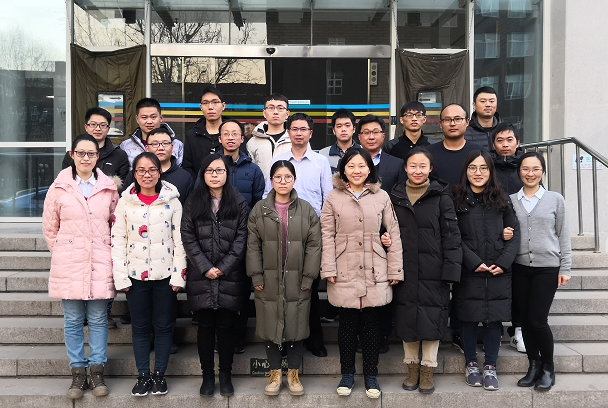
Genetic DNA molecules take four bases (adenine, thymine, cytosine, guanine) exclusively to code heritable information in all the three life kingdoms. Adding, deleting, and substituting any of these bases in the context of genomic sequences would permanently change the genetic information. Endogenous and/or exogenous stresses may cause potent insults on genomes to form DNA damages through reactive oxygen/nitrogen/carbon species or substitution. These damages to DNA bases will cause persistent changes during DNA replication if they are not correctly repaired or bypassed, leading to heritable mutations. Interestingly, on the other hand, there are a few modifications enzymatically set on cytosine, which regulates gene expression and chromosome structures without changing the hereditary sequences. These DNA modifications are usually attributed to epigenetic markers, e.g., 5-methyl-2’-deoxycytidine (5mdC) and its oxidized derivatives.
Our team’s research focuses on development of advanced analytical technologies for detection of DNA modifications (including aberrant DNA damages and epigenetic DNA marks). Based on developed unique analytical technologies (capillary electrophoresis-laser-induced fluorescence polarization, UHPLC-MS/MS, single molecule fluorescence imaging and detection), we further extend our studies on DNA repair mechanisms (in particular, homologous recombination repair) and epigenetic DNA modifications. In terms of homologous recombination repair, we identified unsaturated RecA nucleofilaments and demonstrated these active nucleofilaments play critical roles in bacterial homologous recombination (Cell Discovery, 2017). Essentially, our team for the first time established a direct linkage among vitamin C, Tet dioxygenases, and DNA methylation (JACS, 2013, Google citation 270). As a world-wide seminal work, we discovered new DNA modification (N6-methyladenine) in high eukaryotes (Cell, 2015, Google citation 255).
Research Interests:
(1) Highly sensitive analytical technologies for detection of trace DNA damage and modifications;
(2) DNA repair protein-nucleic acids interactions for study of homologous recombination repair mechanisms;
(3) Eukaryotic N6-methyladenine DNA modification (6mA) and its functions and regulation;
(4) Environment-DNA methylome interactions and health effects.
1.Liu, J.#; Jiang, J.#; Mo, J.#; Liu, D.#; Cao, D.; Wang, H(ailin)*; He, Yufei*; Wang H(ongyang).* Global DNA 5-hydroxymethylcysotine and 5-formylcytosine contents are decreased in the early stage of hepatocellular carcinoma. Hepatology, doi: 10.1002/hep.30146. (IF = 14.079)
2.Yang, X.#; Yang, Y.#; Sun, B. F.#; Chen, Y. S.#; Xu, J. W.#; Lai, W. Y.#; Li, A.; Wang, X.; Bhattarai, D. P.; Xiao, W.; Sun, H. Y.; Zhu, Q.; Ma, H. L.; Adhikari, S.; Sun, M.; Hao, Y. J.; Zhang, B.; Huang, C. M.; Huang, N.; Jiang, G. B.; Zhao, Y. L.; Wang, H. L.*; Sun, Y. P.*; Yang, Y. G.* 5-methylcytosine promotes mRNA export – NSUN2 as the methyltransferases and ALYREF as an m5C reader. Cell Res. 27:606-625 (2017) (Cover, highlighted). (IF = 15.606)
3.Zhao, B.#; Zhang, D#.; Li, C.; Yuan, Z.; Zhong, S.; Jiang, G.; Yang, Y. G.; Le, X. C.; Weinfeld, M.; Zhu P.; Wang, H.* ATpase activity tightly regulates RecA nucleofilaments to promote homologous recombination. Cell Discov. 3:16053 (2017).
4.Zhang, G.#; Huang, H.#; Liu, D.#;, Cheng, Y.; Liu, X.; Zhang, W.; Yin, R.; Zhang, D.; Zhang, P.; Liu, J.; Li,C.; Liu, B.; Luo, Y.; Zhu, Y.; Zhang, N.; He, S.; He, C.; Wang, H.*; Chen, D.* N6-methyladenine DNA modification in Drosophila. Cell, 161:893-906 (2015). (Previewed by Cell, Cover, IF = 31.398) (Google citation: 202)
5.Zhao, C.; Wang, H.*; Zhao, B. L.; Li, C. P.; Yin, R.; Song, M.; Liu, Z.; Jiang, G. B. Boronic acid-mediated polymerase chain reaction for gene- and fragment-specific detection of 5-hydroxymethylcytosine. Nucleic Acids Res., 42: e81 (2014). (IF = 11.561)
6.Zhao, B. L.#; Yang, Y. #; Wang, X.#; Chong Z.; Yin, R.; Song, S. H.; Zhao, C.; Li, C.; Huang, H.; Sun, B. F. Wu, D.; Jin, K. X. Song, M.; Zhu, B. Z.; Jiang, G.; Danielsen, J. M. R.; Xu, G. L.; Yang, Y. G.*; Wang, H.* Redox-active quinones induces genome-wide DNA methylation changes by an iron-mediated and Tet-dependent mechanism. Nucleic Acids Res., 42:1593-1605 (2014). (IF = 11.561)
7.Yin, R.; Mao, S.-Q.; Zhao, B.; Chong, Z.; Yang, Y.; Zhao, C.; Zhang, D.; Huang, H.; Gao, J.; Li, Z,; Jiao, Y.; Li, C.; Liu, S.; Wu, D.; Gu, W.; Yang, Y. G.; Xu, G. L.; Wang, H.* Ascorbic Acid Enhances Tet-mediated 5-Methylcytosine Oxidation and Promotes DNA Demethylation in Mammals. J. Am. Chem. Soc., 135:10396-10403 (2013). (Highlighted by Nature Reviews Genetics) (IF = 14.357) Google citation: 240)
8.Liu, S.; Zhao, B.; Zhang, D.; Li, C.; Wang, H*. Imaging of Non-uniform Motion of Single DNA Molecules Reveals the Kinetics of Varying-Field Isotachophoresis. J. Am. Chem. Soc., 135:4644-4647 (2013). (IF = 14.357)
9.Zhang, D. P.; Lu, M.; Wang, H.* Fluorescence anisotropy analysis for mapping aptamer-protein interaction at the single nucleotide level. J. Am. Chem. Soc., 133: 9188-9191 (2011). (IF = 14.357)
10.Wang, H.; Lu, M.; Tang, M.-S.; Van Houten, B.; Ross, J. B. A.; Weinfeld, M.*; Le, X. C*. DNA wrapping is required for DNA damage recognition in the Escherichia coli DNA nucleotide excision repair pathway. Proc. Natl. Acad. Sci. USA, 106: 12849-12854 (2009).
The grants supported by the Ministry of Science and Technology of China (2016YFC0900300), the National Natural Science Foundation of China (9174321, 21327006, 21435008, and 21621064), and the Strategic Priority Research Program of the Chinese Academy of Sciences (XDB14030200), the Key Research Program of Frontier Sciences, CAS (QYZDJ-SSW-DQC017), and the K. C. Wong Education Foundation.
“National Awardee for Hundred, Thousand and Ten Thousand Talent Engineering Project”
Ministry of Human Resources and Social Security of P. R. China, joined with other six ministries of P.R. China, including Ministry of Science and Technology, Ministry of Education, 2017
“Distinguished Young Scientist”, Excellent Award
Natural Science Foundation of China, 2011-2015
100 Talent Scientists Program, Excellent Award
Chinese Academy of Sciences, Beijing, China, 2005-2009
CAIA Awards Special Medal, 2015
Chinese Association of Instrumental Analysis, Beijing, China
CAIA Awards First Medal, 2010, 2013
Chinese Association of Instrumental Analysis, Beijing, China
CAIA Awards Second medal, 1995, 1998, and 1999
Chinese Association of Instrumental Analysis, Beijing, China
Presidential Special Graduate Award, 1997
Chinese Academy of Sciences, Beijing, China
